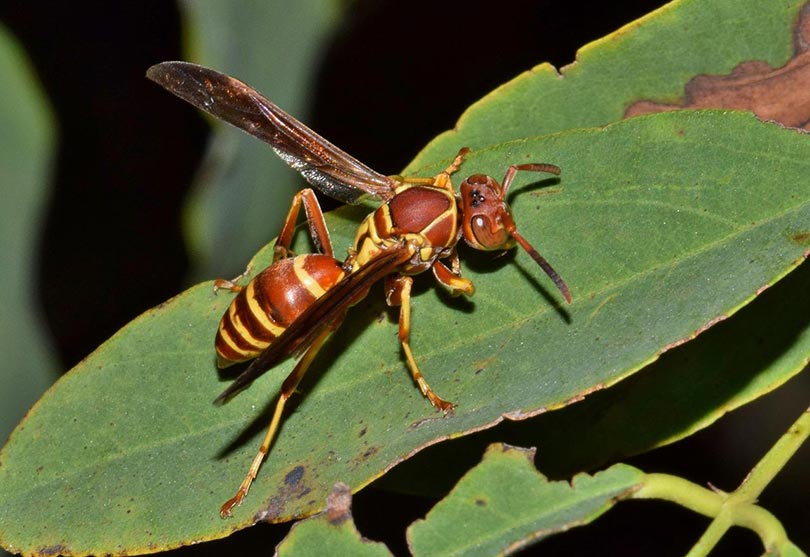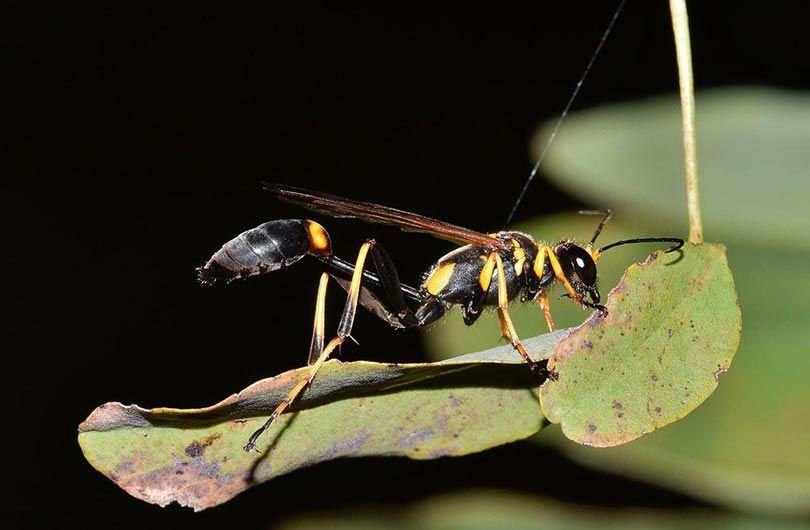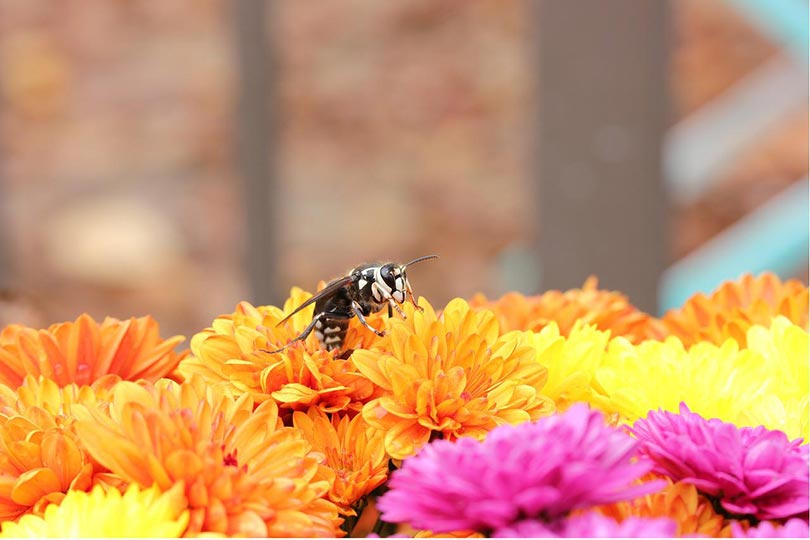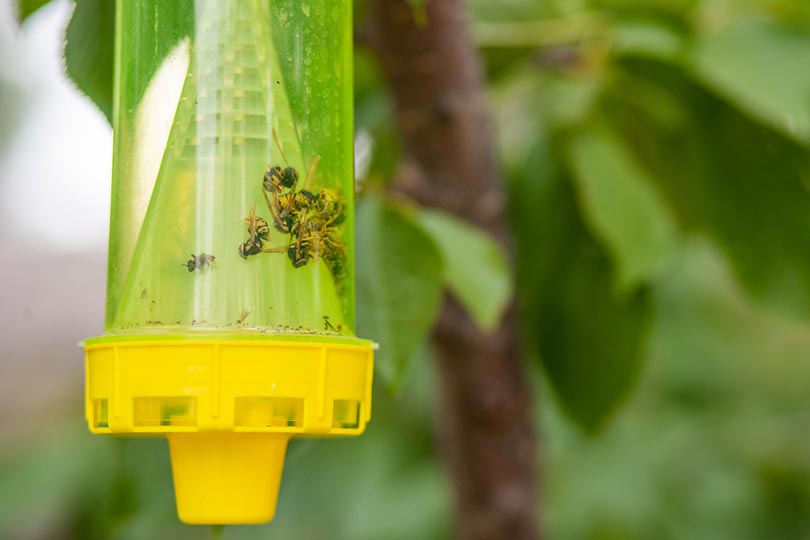How to Get Rid of Wasps: 4 Methods (With Pictures)
-
Pete Ortiz
- Last updated:

According to the National Pest Management Association, warm weather is favorable for wasps. And you have to admit that nobody wants to have wasps around due to their nasty stings, allergic reactions, and destructive habits.
So if you are wondering how to keep them at bay, we have you covered. Hop in to learn the various types of wasps, what attracts them to your home, and the ways you can keep them away. Let’s get started.
The 4 Common Wasp Varieties
There are various types of wasps in our country. Here are some of the common ones:
1. Paper Wasps

Paper wasps come in brownish, yellowish, and even reddish colors. They are so-called because they create paper-like nests resembling inverted umbrellas from saliva and chewed-up wood pieces. You’ll find these nests on eaves, railings, shutters, or decks.
2. The Mud Daubers

Their long, narrow bodies make mud daubers different from other wasps. They also do not dwell in colonies or build nests with others. But, as their name suggests, they use mud to construct tiny nests for themselves. They are black with brilliant yellow stripes on their thorax and legs. This kind will give you little trouble, for they are a docile species.
3. The Bald-Faced Hornets

Black with pale yellow or white streaks, the bald-faced hornet is another common wasp. It is the most hostile wasp that creates football-like grayish nests in buildings, shrubs, or trees. Their large colonies usually build huge, watermelon-sized nests by the end of summer. So you want to be wary of these.
4. Yellowjackets

Yellowjackets are one of the most harmful and widespread wasps in the United States. You can quickly recognize them in their black-striped bodies covered in yellow. You can confuse them with bumblebees and honeybees, but yellowjackets are not fuzzy. They build their nests underground, in hollowed spaces like dead trees and buildings’ walls. They are overly protective of their nests, and they’ll sting mercilessly at any sign of threat.
What Draws Wasps to Your House?
- Food sources: After winter, wasps are usually hungry, so they’ll come to your home to find food. They prey on larvae and insects; hence it is best to eradicate insects and spiders from your home to leave them with zero food sources.
- Leftovers: Wasps love protein-based foods like beef and poultry. So always ensure your food is tightly covered and clean up after spills.
- Sugar: Wasps love sugar from soda cans, fruit juice, and sucrose from fruits.
- Shelter: Wasps come to your yard for refuge from predators and harsh weather elements. That’s why you will spot them in crevices, cracks, and walls.
- Flowers: Wasps like hanging around flowers for the nectar and their scent. That’s why you’ll find them around garden beds.

The 7 Ways to Get Rid of Wasps
1. Use a Blend of Lemongrass, Clove, and Geranium
You can ward off wasps using a blend of lemongrass, geranium, and clove essential oils. Sprinkle the porch roofs, eaves, ledges, home cracks, and areas where wasps build their nests with a solution of each oil mixed with water and dish soap.
Then target those regions where you’ve previously discovered old nests because paper wasps often build their homes in the same spots.
2. Seal Cracks and Plaster Holes
Fill in minor gaps around siding borders and where electricity cables enter the house. Also, patch the holes in window screens, and install caulk where necessary. This should be done in late autumn, when the majority of worker wasps have already passed away, or in the spring when their nests are dormant.
To fill cracks and holes, use a blend of caulk and expanding foam sealant. You’ll even enjoy energy efficiency in your home due to this.
Afterward, ensure you do not have any tears on your windows and doors screens because wasps will squeeze through them. Your attic’s vents and screens should be thin enough to discourage wasps from entering but large enough to enhance airflow.
3. Hang Wasp Traps

One of the most practical ways of eradicating wasps from your home is hanging traps. Then put one of the wasp’s favorite foods, sugar, inside water. The wasp will crawl towards the sugar water, blinded by its smell, and fall into the sticky liquid and drown.
You can quickly make wasp traps by cutting a plastic bottle (preferably a 2-liter soda container) at the top. Then place it inside the bottle’s bottom. Traps will not completely stop the problem because you’ll only catch wasps traveling through the yard and leave those concentrated at the nest. When setting a trap, first, find the nest and then set it nearby.
4. Soap and Water
If you do not want a store-bought insecticide, you can destroy small wasp nests using a mixture of soap and water. Add two teaspoons of dish soap into a water bottle, then spray the nests with the solution. This soapy brew will block their breathing spores and instantly kill them.
5. Peppermint Oil
You can repel wasps successfully using peppermint oil. Put peppermint oil in a spray bottle, mix it with water and spray it on porches, shrubs, and trees.
6. Cover Your Food and Trash
Maintaining a clean environment is vital if you want to get rid of wasps. Food waste, sweets, trash, and poorly washed garbage containers attract yellow jackets. Keep your food and drinks covered when you have food, especially during events.
Garbage bin lids should also be tightly closed to prevent the coming of the yellow jackets. And if your compost pile is causing problems, consider composting indoors.
7. Use Store-Bought Insecticide
Use store-bought insecticides to eliminate individual wasps from your home. Spray it on the nests and insect-driven places such as a wood fence, patio, pool, and deck. Ensure you wear protective clothing and spray when the wasps are docile, mostly when it’s cool outside.
Conclusion
These practical tips will ensure you enjoy your home without unnecessary guests. And the great thing is, you can quickly implement some of these tips at home without consulting an expert!
However, dealing with wasp infestations can be time-consuming, especially if they are in colonies. Remember, wasps are very aggressive and dangerous. So if the problem is extensive, please do not hesitate to contact a pest control professional.
Pest management officials will remove indoor wasps and nests for a more secure home. The colonies typically get worse by the day, so remember to address the problem as soon as possible!
Featured Image Credit: MabelAmber, Pixabay
Contents


